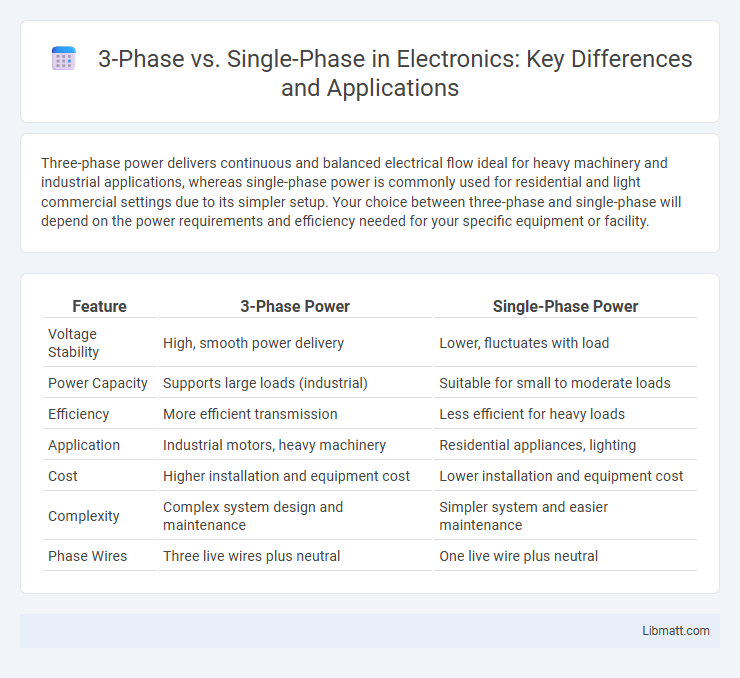Three-phase power delivers continuous and balanced electrical flow ideal for heavy machinery and industrial applications, whereas single-phase power is commonly used for residential and light commercial settings due to its simpler setup. Your choice between three-phase and single-phase will depend on the power requirements and efficiency needed for your specific equipment or facility.
Table of Comparison
| Feature | 3-Phase Power | Single-Phase Power |
|---|---|---|
| Voltage Stability | High, smooth power delivery | Lower, fluctuates with load |
| Power Capacity | Supports large loads (industrial) | Suitable for small to moderate loads |
| Efficiency | More efficient transmission | Less efficient for heavy loads |
| Application | Industrial motors, heavy machinery | Residential appliances, lighting |
| Cost | Higher installation and equipment cost | Lower installation and equipment cost |
| Complexity | Complex system design and maintenance | Simpler system and easier maintenance |
| Phase Wires | Three live wires plus neutral | One live wire plus neutral |
Introduction to Electrical Phases
Three-phase electrical systems deliver power using three alternating currents, each offset by 120 degrees, ensuring continuous energy flow and higher efficiency for industrial applications. Single-phase systems use a single alternating current, typically suitable for residential and light commercial use, providing simpler wiring and lower installation costs. The choice between three-phase and single-phase affects power quality, load capacity, and overall energy distribution efficiency.
Understanding Single-Phase Power
Single-phase power delivers alternating current through two wires, typically used for residential and light commercial applications due to its simplicity and cost-effectiveness. It provides a consistent voltage supply, usually 120 or 240 volts, suitable for powering everyday appliances and small motors. Understanding single-phase power is essential for optimizing your home's electrical system and ensuring efficient energy use without the complexity of three-phase setups.
What is 3-Phase Power?
3-phase power is a type of alternating current (AC) electrical system that uses three separate conductors carrying currents that are out of phase by 120 degrees, providing a more efficient and balanced power distribution. It delivers continuous power transfer, which improves the performance of motors and heavy machinery compared to single-phase power, which has only one alternating current waveform. Widely used in industrial and commercial applications, 3-phase power reduces energy loss and supports higher power loads with greater stability.
Key Differences Between 3-Phase and Single-Phase
Three-phase power systems deliver electricity through three alternating currents, each 120 degrees out of phase, enabling consistent and efficient power transfer ideally suited for industrial and large commercial applications. Single-phase power utilizes a single alternating current, making it simpler and more cost-effective for residential and light commercial use but less efficient for heavy loads. The primary differences lie in power delivery efficiency, load handling capacity, and application suitability, with three-phase offering higher power density and smoother operation for large motors and equipment.
Applications of Single-Phase Systems
Single-phase systems are commonly used in residential and small commercial applications where power demand is relatively low, typically under 10 kW. These systems efficiently supply electricity to lighting, heating, and small appliances, providing a simpler and cost-effective solution compared to three-phase systems. Single-phase power is also prevalent in rural or remote areas where infrastructure for three-phase power is unavailable or impractical.
Industrial and Commercial Uses of 3-Phase Systems
3-phase systems are widely used in industrial and commercial settings due to their ability to deliver consistent and efficient power for heavy machinery and large electrical loads. These systems provide balanced power, reducing energy losses and improving equipment lifespan. Your facility can benefit from the enhanced reliability and cost savings that 3-phase power offers compared to single-phase systems, especially in operations demanding high power capacity.
Advantages of 3-Phase Over Single-Phase
Three-phase power systems provide more consistent and efficient energy delivery compared to single-phase systems, resulting in smoother operation of heavy machinery and industrial equipment. They allow for reduced conductor material usage and lower energy losses, leading to cost savings in both installation and operation. Higher power capacity and better load balancing capabilities make three-phase systems ideal for commercial and industrial applications.
Cost and Installation Considerations
Single-phase systems typically have lower upfront costs and simpler installation processes, making them suitable for residential properties with moderate power needs. Three-phase systems involve higher initial expenses due to more complex wiring and equipment requirements but offer greater efficiency and scalability for commercial or industrial applications. Installation of three-phase power may require specialized technicians and coordination with the utility provider, impacting overall project timelines and costs.
Choosing the Right Power System for Your Needs
Selecting the appropriate power system depends on the load requirements and application type. Single-phase power suits residential and light commercial use with loads typically under 10 kW, offering simplicity and lower installation costs. Three-phase power is ideal for heavy industrial or commercial operations exceeding 10 kW, providing greater efficiency, balanced load distribution, and the capacity to power large motors and equipment.
Conclusion: Which Phase System is Best?
Three-phase systems offer superior efficiency, power delivery, and stability, making them ideal for industrial and large-scale applications requiring consistent high power. Single-phase systems are more cost-effective and simpler to install, best suited for residential and light commercial use with lower power demands. Choosing the best phase system depends on the specific power requirements, installation complexity, and cost considerations of the application.
3-phase vs Single-phase Infographic

 libmatt.com
libmatt.com